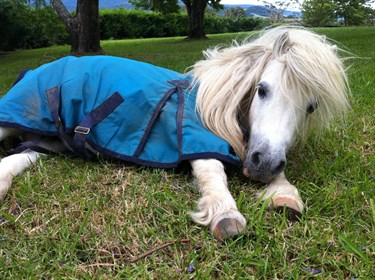|

It has become routine (and even fashionable) for many domestic horses to be rugged all year round – in fly-sheets, all-weather turnouts, stable rugs, fleeces or perhaps even a onesie. Rugs can be useful in protecting horses from biting insects and in adverse weather conditions, however until now there have been very few studies on rugging at all and none on the effect of different types of rugs on a horse’s body temperature.
Like humans, horses have a ‘thermoneutral zone’ (TNZ) – an optimal range of temperatures within which they can comfortably maintain their own body temperature. For adult horses in mild climates, this is between 5 degrees celsius and 25 degrees celsius.
Humans, on the other hand, have a more limited TNZ of between 25 degrees celsius – 30 degrees celsius when naked. This means when humans feel cold, horses are still well within their comfortable zone. Humans often make decisions about rugging their horses based on whether they feel cold themselves, so they may well be using a rug on their horse when it really is not necessary.
Kim Hodgess, a MSc student from Duchy College, UK, carried out a pilot study to investigate how the use of different rugs affects horse temperature, and how this could impact horse welfare. She then presented her findings at the 14th International Society of Equitation Science (ISES) conference in Rome in September.
The research team studied horses who were routinely rugged as part of their management routine, ten kept stabled indoors and two at pasture. Three of the horses wore sweet itch rugs (a sweet itch rug is a lightweight, non-waterproof rug that is used to protect the horse from biting insects and cover the majority of the horse’s body including the neck and belly), six wore fleeces, two wore light quilted rugs and two control horses were unrugged (one stabled and one at pasture).
The surface temperature of each horse was taken by taping a small temperature data logger directly on to each horse, just below the point of their hip. The environmental temperature was also recorded using temperature data loggers attached to either the horse’s stable door or to a wooden mounting block in the field. All temperatures were then recorded every minute for twenty-four hours.
The results showed significant differences between the temperature of the horses wearing different rugs.
The horses wearing sweet itch rugs had an average temperature increase of 4.2 degrees celsius, those wearing fleeces 11.2 degrees celsius and those wearing light quilted rugs had an average increase of 15.8 degrees celsius.
The horses wearing fleece and light quilted rugs were found to have a significant increase in surface temperature. Four rugged horses had surface temperatures between 24 degrees celsius – 30 degrees celsius, compared to the control horses at 12.5 degrees celsius –18.5 degrees celsius, when the environmental temperature had fallen below the TNZ to 4 degrees celsius–4.5 degrees celsius.
The researchers concluded that some types of rugs can significantly increase horse surface temperature beyond temperatures that are comfortable for the horse and could therefore compromise the horses’ capacity to regulate their own temperature.
While the use of rugs and blankets may be necessary for some horses, selecting the right type and weight of rug for your horse and his individual conditions is vital. Appropriate use and application must be seriously considered to ensure they do not have a detrimental impact on horse welfare.
From researcher Kim Hodgess:
"This study was interesting for me as it has left me asking many more questions about the welfare of rugged horses. Questions that remain unanswered for me are: do dark coloured sweet itch rugs increase horse temperature, do rugs interfere with mutual grooming and can skin condition deteriorate with prolonged use of rugs."
"Although this study found sweet itch rugs had no impact on thermoregulation, I feel further research with a larger number of horses, in hotter weather conditions, with a mix of dark and light coloured sweet itch rugs is required before we can be certain there are no negative impacts on equine welfare."
"I would like to continue this area of research, as I feel there is a lot more that could be investigated. A greater understanding of the impact rugs have on horse thermoregulation would help inform our rugging decisions, which has the potential to improve horse welfare."
Keep up to date with the all the latest news from the conference on social media by following #ISESROME2018
Save the date of August 19-21 for the 2019 ISES Conference being held in Guelph, Ontario, Canada. The theme of "Bringing science to the stable" will explore our relationship with horses through the past, present and future. Check the ISES website for conference updates.
To stay informed about the International Society of Equitation Science, sign up for our email news and like the ISES Facebook page for updates. If you are a current ISES member, you can also request to join the discussions on the closed Facebook group, ISES Members Forum.
Source: International Society for Equitation Science
READ THE LATEST NEWS ARTICLES HERE

|

